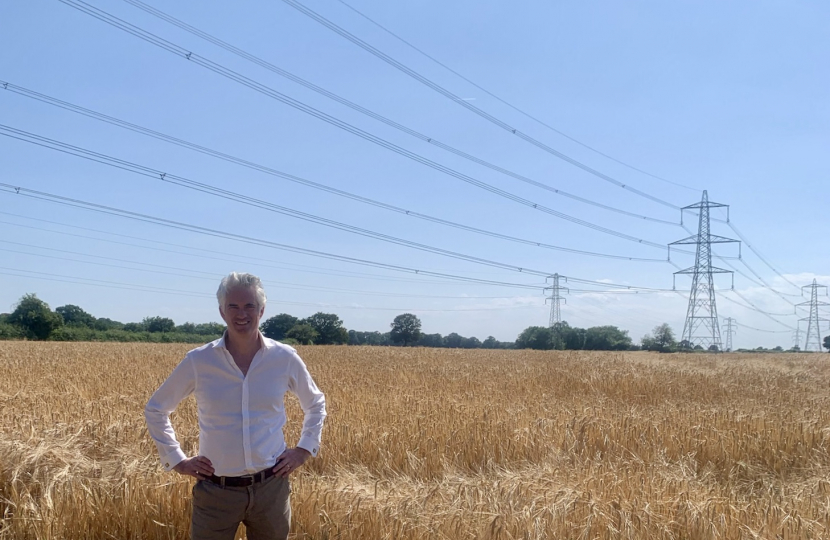
With ongoing coverage of the pylons issue, including in the SFP, I thought it would be helpful to provide an overview of latest developments; not least as there is considerable complexity. I am also aware of how much anxiety this issue causes for those who may be directly affected. There are essentially four strands to the overview.
Firstly, there is the long-running campaign by the OffSET (Offshore Electricity-Grid Taskforce) group of East Anglian MPs, including myself as a founder member, who have been pushing since summer 2020 for a fully coordinated offshore grid – intended to carry our bountiful offshore electricity directly, under the sea, from our region’s wind farms to the demand centre of London.
Our campaign predates the second strand – the planning application for new pylons previously known as ‘East Anglia GREEN’ but now called Norwich to Tilbury; a 180km line of overhead lines through Norfolk, Suffolk, and Essex. The third strand is the Offshore Coordination Support Scheme (OCSS), which was introduced to provide grant funding for the development of coordinated options for offshore transmission infrastructure. Fourthly and finally, there is the Electricity System Operator’s (ESO) review, looking at offshore transmission alternatives.
When National Grid first came forward with their pylon proposals in April 2022, it was mapped as a single ‘purple swathe’ across open countryside from Norwich to Tilbury, with no accompanying proposal for offshore transmission. This was a ‘Henry Ford’ choice of routes – no choice at all.
After calling for an independent review of offshore options to the pylons for many months, I was therefore delighted when ESO agreed earlier this year to conduct a study to identify undersea alternatives that would give my constituents the transparent comparative data they and I have been crying out for. Crucially, it was agreed that this study would also benchmark costings against other projects elsewhere in the UK, comparing not just onshore and offshore costs in East Anglia, but comparing proposed offshore costs in our region with what has been spent on offshore transmission in the north.
Unfortunately, the next round of National Grid’s non-statutory consultation, running until the 21st of August, will conclude before we get the ESO review. This is most disappointing, and I have expressed my dissatisfaction to National Grid in the strongest terms – we should have aligned the offshore review with their planning process.
It is true that constituents engaging with National Grid’s next stage consultation will see that they have finally presented an offshore option which, at a cost of approx. £4 billion and 220km undersea, is the ‘straw man’ I predicted some months ago we would get - unlikely to ever go ahead due to its sheer scale and cost, and not the joined-up solution benefitting both communities and industry.
This means that the next step for offshore campaigners is the imminent publication of the OCSS investments, showing where windfarm projects could be coordinated. Crucially, it is following this that ESO will then launch their review, and I should stress that its remit will be to see to what extent the OCSS work has changed the core transmission needs of the network. In essence, they’ll be asking – do we still need the same scale of onshore reinforcement, i.e., pylons? If we do, can we go offshore instead, to avoid new pylons? If so, at what cost and over what time frame? I’ve been assured this means that ESO’s study will present at least one option as an alternative to Norwich to Tilbury, which would not include a single pylon.
I suspect it is possible that the result of the OCSS and ESO review will be that some parts of our region no longer get the pylons they were dreading – but could be a short-term, pyrrhic victory if the following years see more such infrastructure come forward, because we avoided what remains the best goal in my view – a comprehensive, future-proofed, coordinated offshore grid.
Ultimately, we cannot guarantee that the proposed pylons won’t go ahead. Instead, what we can do is ensure that as much transparency as possible is forthcoming from the planning applicant – National Grid – enabling my constituents to make their representations with the maximum of knowledge, where some months ago our discourse was shrouded in a complete lack of information. I remain incredibly proud of the way we have cut our CO2 emissions as a country and struck back at Putin’s weaponization of energy through the expansion of offshore wind – but such progress cannot be at disproportionate cost to our rural way of life.
Published in the Suffolk Free Press.


